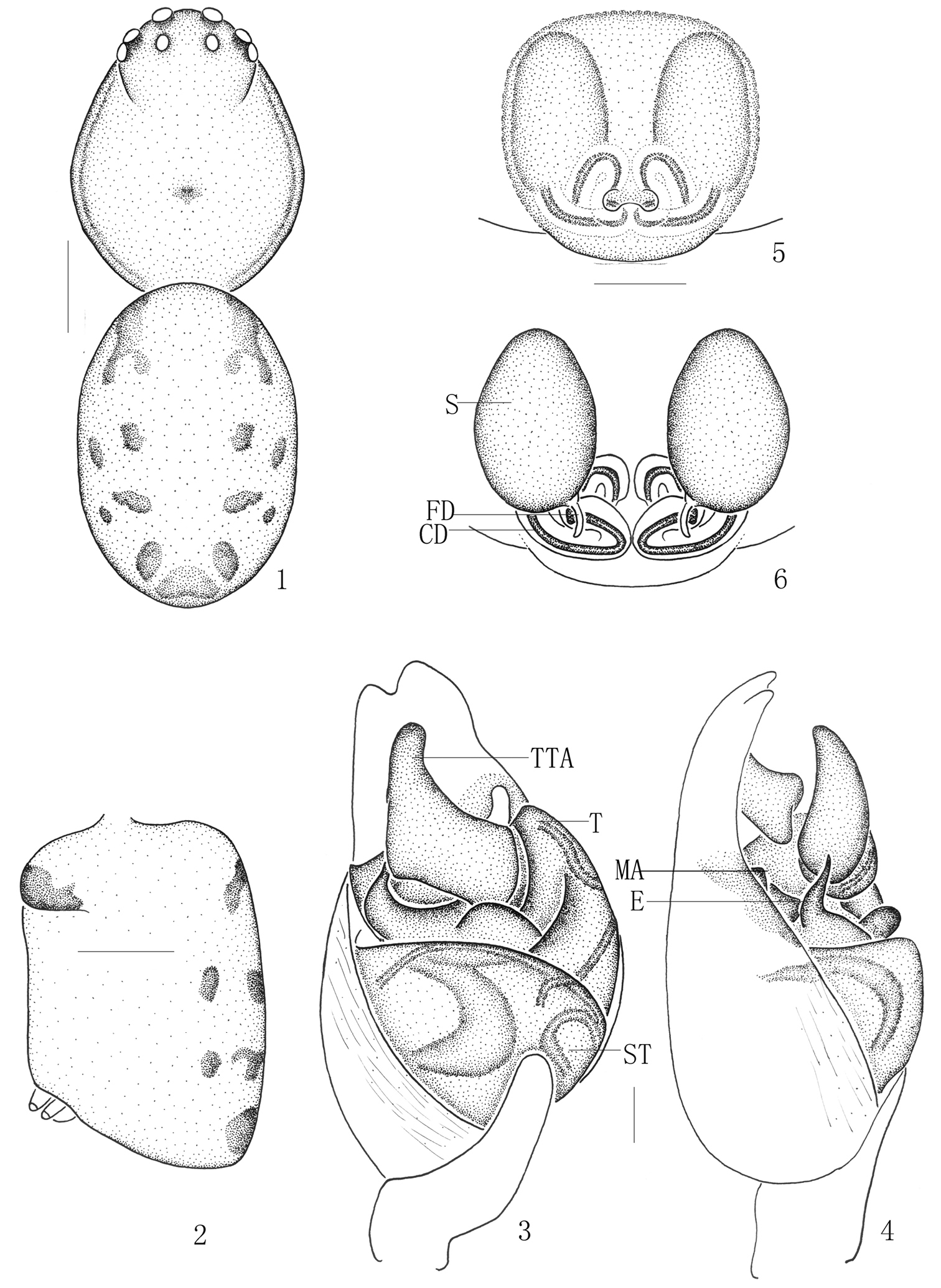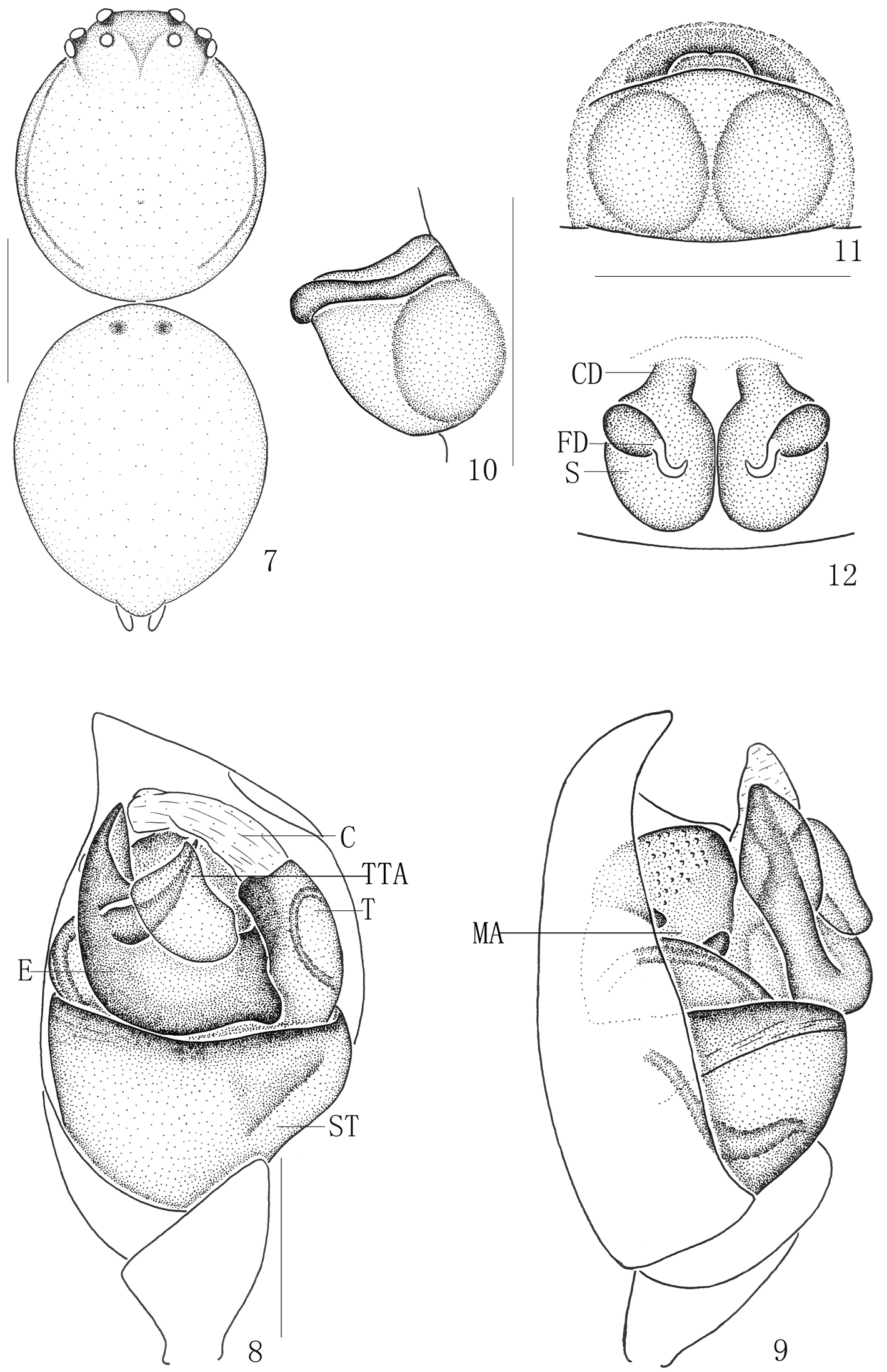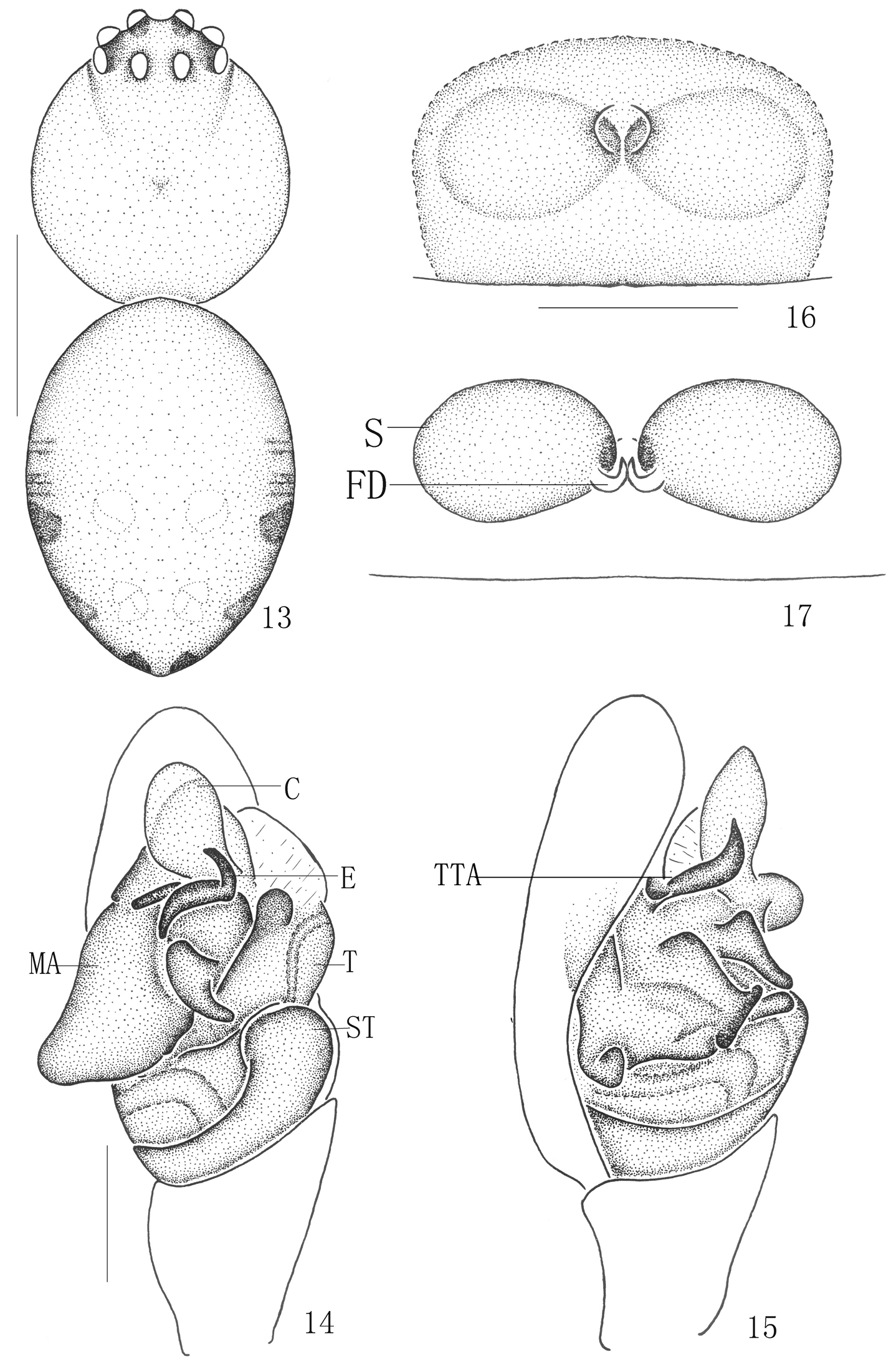






(C) 2012 Bao-Shi Zhang. This is an open access article distributed under the terms of the Creative Commons Attribution License 3.0 (CC-BY), which permits unrestricted use, distribution, and reproduction in any medium, provided the original author and source are credited.
For reference, use of the paginated PDF or printed version of this article is recommended.
Two new spider species of the genus Chrysso O. P.-Cambridge, 1882 are reported from Hainan Island, China, Chrysso bifurcasp. n. (male, female) and Chrysso bicuspidatasp. n. (male, female). Chrysso bimaculata Yoshida, 1998is recorded from China for the first time.
Chrysso, taxonomy, new species, newly recorded, China
The genus Chrysso was erected by O. P.-
Currently 62 Chrysso species are reported, mostly from America and Asia (
During the examination of spider specimens collected from 2007 to 2009 in Hainan Island, China, two new species, Chrysso bifurca sp. n. and Chrysso bicuspidata sp. n. were recognized and are described here. Chrysso bimaculata Yoshida, 1998, known from Japan previously, is newly recorded from Hainan, China.
Material and methodsAll specimens were kept in 75% ethanol and examined, drawn and measured under a Tech XTL-II stereomicroscope equipped with an Abbe drawing device. Carapace length was measured medially from the anterior margin to the rear margin of the carapace. Eye sizes were measured as the maximum diameter of the lens in dorsal or frontal view. MOA length was measured medially from the anterior margin to the rear margin of MOA. Leg measurements are given as: total length (femur, patella, tibia, metatarsus, tarsus). Epigynes were cleared in warm potassium hydroxide (KOH) and transferred to 75% ethanol for drawing. The labeling of the palpal sclerites is adopted following
AER anterior eye row
ALE anterior lateral eyes
AME anterior median eyes
C conductor
CD copulatory ducts
E embolus
FD fertilization ducts
MA median apophysis
MOA median ocular area
PER posterior eye row
PLE posterior lateral eyes
PME posterior median eyes
S spermathecae
ST subtegulum
T tegulum
TTA theridiid tegular apophysis
Taxonomyurn:lsid:zoobank.org:act:5B93397C-1884-4E05-9738-5B5A003645A6
http://species-id.net/wiki/Chrysso_bifurca
Figs 1–6Holotype ♂, CHINA, Hainan Island: Jianfengling Mountain (19°07'N, 109°13'E), 29 May 2009, C. Zhang leg. Paratypes: 2 ♀, same data as holotype; 1 ♀, Limu Mountain (19°10'N, 109°39'E), 20 August 2007, C. Zhang leg.; 3 ♂, 12 ♀, Limu Mountain, 20 November 2008, G.X. Han leg.
Chrysso bifurca sp. n., 1–4 male holotype 1 body, dorsal view 2 abdomen, lateral view 3 male left palp, ventral view 4 same, prolateral view 5–6 female paratype 5 epigynum, ventral view 6 vulva, dorsal view. Scale bars: 0.5 mm (1–2); 0.1 mm (3–6).
Diagnosis. Males can be distinguished from other Chrysso species by the following characters: apex of cymbium bifurcate; embolus short and thin; theridiid tegular apophysis erect, with obtuse apex (Figs 3–4). Females differ from other Chrysso species by the bigger and oval spermathecae, and the longer and winding copulatory ducts, differ from Chrysso octomaculata (Bösenberg & Strand, 1906) by the process of copulatory ducts (Fig. 6).
The species name refers to bifurcate apex of cymbium.
Male (holotype). Total length 2.70: cephalothorax 1.26 long, 1.08 wide; abdomen 1.44 long, 0.99 wide, 0.90 high. Carapace yellow, longer than wide, lateral margin with thin black striations. Only anterior part with several gray setae. Cervical groove distinct. Median furrow almost triangle, yellowish. Each eye with a black ring. Both the eye rows recurved from dorsal view (Fig. 1). Diameters of eyes: AME 0.12, ALE 0.10, PME 0.10, PLE 0.10. Interdistances of eyes: AME–AME 0.10, AME–ALE 0.08, ALE–ALE 0.64, PME–PME 0.10, PME–PLE 0.14, PLE–PLE 0.66, ALE and PLE closed to each other. MOA long 0.29, front width 0.34, back width 0.31. Clypeus 0.32 high, yellow and furnished with few short gray setae. Chelicerae armed with sparse gray setae, promargin with 2 teeth, fangs short and thin. Anterior margin of endites armed with gray scopula. Labium armed with sparse long black setae. Sternum furnished with sparse black setae, its anterior margin lightly procurved. Legs yellow, patella, metatarsus and the base of femur and tibia reddish-brown. Measurements of legs: leg I 9.44 (2.52, 0.59, 2.55, 2.88, 0.90), II 4.38 (1.49, 0.45, 1.13, 0.90, 0.41), III 3.16 (0.90, 0.36, 0.59, 0.90, 0.41), IV 5.09 (1.58, 0.36, 1.17, 1.44, 0.54). Leg formula: 1423.
Abdomen oval, longer than wide and armed with brown setae. Dorsum yellowish, armed with six pairs of irregular black patches, posterior with a median black patch (Figs 1–2). Venter yellowish, with a black median patch. Anal tubercle yellow. Spinnerets yellow.
Male palp with long cymbium, apical part of cymbium bifurcate; embolus short, base with a lunate process, distal part thin; theridiid tegular apophysis erect, with wide base, apex thin and obtuse; conductor lying behind theridiid tegular apophysis (Figs 3–4).
Female (one paratype from Jianfengling Mountain) total length 3.33: cephalothorax 0.95 long, 0.94 wide; abdomen 2.34 long, 1.62 wide, 1.58 high. Diameters of eyes: AME 0.12, ALE 0.10, PME 0.10, PLE 0.10. Interdistances of eyes: AME–AME 0.13, AME–ALE 0.09, ALE–ALE 0.59, PME–PME 0.14, PME–PLE 0.16, PLE–PLE 0.61, ALE and PLE closed to each other. MOA long 0.27, front width 0.30, back width 0.31. Clypeus 0.32 high. Measurements of legs: leg I10.81 (3.24, 0.63, 2.70, 3.29, 0.95), II 6.44 (2.03, 0.54, 1.44, 1.80, 0.63), III 3.52 (1.13, 0.41, 0.63, 0.90, 0.45), IV 7.08 (1.94, 0.54, 2.21, 1.80, 0.59). Leg formula: 1423. Other characters as in holotype.
Female genitalia lightly sclerotized, posterior part with a kidney-shaped atrium; spermathecae big, oval; copulatory ducts long, thick, winding and connected with spermathecae from posterior part (Figs 5–6).
The new species with putative Chrysso synapomorphies as follow:(1) carapace pars stridens irregular; (2) abdomen extending beyond spinnerets; (3) cymbial hood of male palp broad; (4) median apophysis of male palp with distinct apophysis; (5) palpal claw of female dentition sparse.
The lateral part of dorsal abdomen of some females examined with eight to eleven pairs of irregular black patches. Males total body length from 2.64–2.80, female total length from 3.28–3.35.
China (Hainan).
urn:lsid:zoobank.org:act:660AA46B-0F72-4257-A1FC-8B734804876B
http://species-id.net/wiki/Chrysso_bicuspidata
Figs 7–12Holotype ♂, CHINA, Hainan Island: Jianfengling Mountain, 29 May 2009, C. Zhang leg. Paratypes: 2 ♀, same data as holotype; 3 ♀, Jianfengling Mountain, 12 November 2008, G.X. Han leg.; 3 ♂, 1 ♀, Bawangling Mountain (19°07'N, 109°04'E), 25 May 2009, C. Zhang leg.; 5 ♀, Bawangling Mountain, 7 November 2008, G.X. Han leg.; 2 ♂, 1 ♀, Diaoluo Mountain (18°45'N, 109°45'E), 6 June 2009, C. Zhang leg.; 1 ♂, 2 ♀, Limu Mountain, 19 August 2007, F. Zhang leg.
Chrysso bicuspidata sp. n., 7–9 female holotype 7 body, dorsal view 8 male left palp, ventral view 9 same, prolateral view 10–12 female paratype 10 epigynum, lateral view 11 same, ventral view 12 vulva, dorsal view. Scale bars: 0.5 mm (7); 0.1 mm (8–12).
Males can be distinguished from most Chrysso species by membranous conductor, wider embolus and acuate apex of cymbium. And it resembles Chrysso cyclocera Zhu, 1998 and Chrysso oxycera Zhu & Song, 1993 in the general shape of the palpal organ, but differs from them by the wider embolus (Figs 8–9). Females differ from all other Chrysso species except Chrysso viridiventris Yoshida, 1996 by the epigynum with a big atrium and a large posterior lobe. It differs from Chrysso viridiventris by the bigger spermathecae and shorter copulatory ducts (Figs 10–12).
The species name refers to the shape of embolic tip.
Male (holotype). Total length 1.84: cephalothorax 0.92 long, 0.71 wide; abdomen 0.92 long, 0.82 wide, 0.92 high. Carapace longer than wide, yellowish, lateral margin with thin black striations, anterior median with a triangular black patch. Only anterior part with several gray setae. Cervical groove yellowish. Median furrow yellowish, almost triangle. Each eye with a black ring. Both the eye rows recurved from dorsal view (Fig. 7). Diameters of eyes: AME 0.05, ALE 0.04, PME 0.04, PLE 0.04. Interdistances of eyes: AME–AME 0.10, AME–ALE 0.03, ALE–ALE 0.33, PME–PME 0.10, PME–PLE 0.08, PLE–PLE 0.38, ALE and PLE closed to each other. MOA long 0.13, front width 0.18, back width 0.18. Clypeus 0.20 high and furnished with few short gray setae. Chelicerae armed with sparse gray setae, promargin with 2 teeth, fangs short and thin. Endites, labium and sternum yellowish. Anterior margin of endites armed with gray scopula. Sternum furnished with sparse gray setae. Legs yellowish, the end of tibia with gray spots. Measurements of legs: leg I 7.14 (1.94, 0.41, 1.94, 1.63, 1.22), II 3.69 (1.33, 0.31, 0.82, 0.82, 0.41), III 2.14 (0.71, 0.20, 0.31, 0.61, 0.31), IV 3.86 (1.12, 0.31, 0.82, 1.20, 0.41). Leg formula: 1423.
Abdomen oval, longer than wide and armed with brown setae. Dorsum yellowish, anterior part with a pair of black patches (Fig. 7). Venter yellowish. Spinnerets yellowish.
Apical cymbium of male palp acuate; embolus big, thick, and end with a thin ramus; conductor membranous, falciform from ventral view; apex of median apophysis with some small tubers (Figs 8–9).
Female (one paratype from Limu Mountain) total length 2.32: cephalothorax 0.92 long, 0.71 wide; abdomen 1.43 long, 1.22 wide, 1.43 high. Diameters of eyes: AME 0.05, ALE 0.05, PME 0.03, PLE 0.05. Interdistances of eyes: AME–AME 0.05, AME–ALE 0.02, ALE–ALE 0.30, PME–PME 0.09, PME–PLE 0.08, PLE–PLE 0.33, ALE and PLE closed to each other. MOA long 0.13, front width 0.15, back width 0.15. Clypeus 0.30 high. Measurements of legs: leg I 7.75 (2.24, 0.51, 1.94, 2.35, 0.71), II 3.59 (1.24, 0.31, 0.71, 0.92, 0.41), III 2.04 (0.71, 0.20, 0.31, 0.51, 0.31), IV 3.79 (1.24, 0.31, 0.81, 1.02, 0.41). Leg formula: 1423. Dorsal abdomen yellowish. Other characters as in holotype.
Female genitalia lightly sclerotized, and with a circular atrium and a large posterior lobe; spermathecae big, oval; copulatory ducts short, thick and connected with spermathecae from anterior part; each fertilization duct with a global head (Figs 10–12).
The new species with putative Chrysso synapomorphies as follow:(1) carapace pars stridens smooth; (2) abdomen extending beyond spinnerets; (3) cymbial hood of male palp broad; (4) subconductor of male palp present; (5) median apophysis of male palp with apophysis; (6) palpal claw of female dentition sparse; (7) anterior margin of female genital atrium medially acute.
The anterior part of dorsal abdomen of some species examined with a pair of black patches, some species without. Males total body length from 1.73–1.88, females total length from 2.22–2.35.
China (Hainan).
http://species-id.net/wiki/Chrysso_bimaculata
Figs 13–17CHINA, Hainan Island: 1 ♂, 1 ♀, Jianfengling Mountain, 31 May 2009, C. Zhang leg.; 1 ♀, Bawangling Mountain, 6 November 2008, G.X. Han leg.; 1 ♀, Bawangling Mountain, 25 May 2009, C. Zhang leg.; 5 ♀, Limu Mountain, 29 August 2007, G.X. Han leg.; 1 ♂, 3 ♀, Limu Mountain, 21 November 2008, G.X. Han leg.
Chrysso bimaculata Yoshida, 1998 13–15 male 13 body, dorsal view 14 male left palp, ventral view 15 same, prolateral view 16–17 female 16 epigynum, ventral view 17 vulva, dorsal view. Scale bars: 0.5 mm (13); 0.1 mm (14–17).
Male (one specimen from Jianfengling Mountain) total length 1.40: cephalothorax 0.59 long, 0.54 wide; abdomen 0.81 long, 0.59 wide, 0.54 high. Carapace longer than wide, yellowish. Cervical groove yellowish. Median furrow yellowish and almost triangle. Each eye with a red ring. AER recurved and PER procurved from dorsal view (Fig. 13). Diameters of eyes: AME 0.08, ALE 0.07, PME 0.07, PLE 0.07. Interdistances of eyes: AME–AME 0.08, AME–ALE 0.07, ALE–ALE 0.34, PME–PME 0.08, PME–PLE 0.06, PLE–PLE 0.36, ALE and PLE closed to each other. MOA long 0.18, front width 0.18, back width 0.17. Clypeus 0.16 high and furnished with few short gray setae. Chelicerae armed with sparse black setae, promargin with 2 teeth. Endites, labium and sternum yellowish. Anterior margin of endites armed with gray scopula. Sternum furnished with sparse black setae. Legs yellow, the end of tibia yellow brown. Measurements of legs: leg I 5.10 (1.44, 0.36, 1.22, 1.58, 0.50), II 3.07 (0.99, 0.32, 0.63, 0.77, 0.36), III 1.81 (0.50, 0.23, 0.45, 0.36, 0.27), IV 3.20 (1.17, 0.27, 0.63, 0.77, 0.36). Leg formula: 1423.
Abdomen oval, armed with gray setae. Dorsum yellowish, posterior part with two pairs of white patches, lateral part armed with three pairs of black patches and several black stripes (Fig. 13). Venter yellowish. Spinnerets yellowish.
Embolus of male palp small, thin and wind; conductor wind, membranous; median apophysis big, posterior part with a small tuber from prolateral view (Figs 14–15).
Female (one specimen from Jianfengling Mountain) total length 1.80: cephalothorax 0.63 long, 0.54 wide; abdomen 1.08 long, 0.95 wide, 1.04 high. Diameters of eyes: AME 0.08, ALE 0.07, PME 0.07, PLE 0.07. Interdistances of eyes: AME–AME 0.09, AME–ALE 0.03, ALE–ALE 0.35, PME–PME 0.10, PME–PLE 0.07, PLE–PLE 0.38, ALE and PLE closed to each other. MOA long 0.17, front width 0.17, back width 0.20. Clypeus 0.16 high. Measurements of legs: leg I 4.73 (1.35, 0.27, 1.17, 1.44, 0.50), II 2.81 (0.90, 0.23, 0.59, 0.77, 0.32), III 1.95 (0.63, 0.18, 0.32, 0.50, 0.32), IV 2.94 (0.95, 0.27, 0.59, 0.77, 0.36). Leg formula: 1423. Other characters as in holotype.
Female genitalia lightly sclerotized, median part with a circular atrium; spermathecae oval; the copulatory ducts very short (Figs 16–17).
The amount of white patches and black patches of dorsal abdomen variated from two pairs to three pairs. Males total body length of some species examined from 1.40–1.55, females total length from 1.68–1.82.
China (Hainan), Japan.
We are grateful to Dr. Dimitar Dimitrov, Dr. Ingi Agnarsson and an anonymous referee for valuable suggestions. We are also grateful to Chao Zhang and Guangxin Han for the collection of specimens. This study was supported by the Ministry of Science and Technology of the People’s Republic of China (2006FY110500), the National Natural Science Foundation of China (No. 31071885, 30970325, 31093430), and partly by the Education Office of Hebei Province, China (No. Z2009101), and the Natural Science Foundation of Baoding University (No. 2010Z01).


